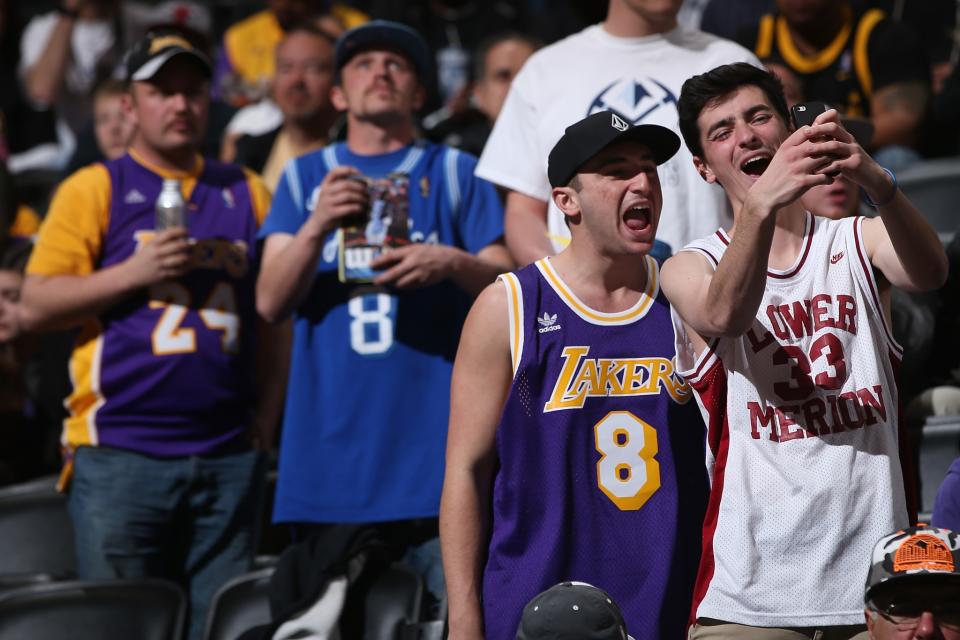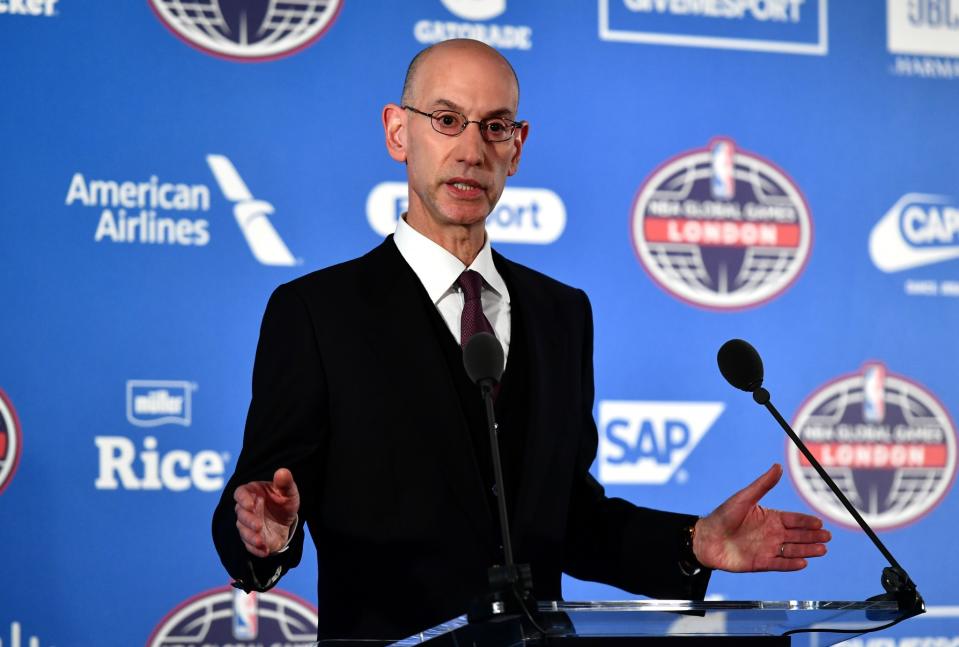The NBA wants to speed up games to suit 'short millennial attention spans'

Over the past five years, NBA decision-makers have toyed with all sorts of ways to speed up games and shorten the total amount of time it takes for two teams to play 48 minutes. Blow more horns to keep timeouts from running long! A 90-second pre-tipoff clock to cut down on time-wasting pregame handshakes! Literally cutting four minutes off the game!
Before Thursday’s meeting between the Denver Nuggets and Indiana Pacers at O2 Arena in jolly ol’ London, NBA Commissioner Adam Silver reiterated his league’s commitment to trying to shave every last second it can off of games, because … well, because today’s young people just can’t properly appreciate the truly bold and rich flavors of a timeout-filled tactical back-and-forth.
[Join a Yahoo Daily Fantasy Basketball contest now | Free NBA Yahoo Cup entry]
From ESPN.com’s Tom Hamilton:
“It’s something that I know all of sports are looking at right now, and that is the format of the game and the length of time it takes to play the game,” Silver said. “Obviously people, particularly millennials, have increasingly short attention spans, so it’s something as a business we need to pay attention to.” […]
“When the last few minutes of the game take an extraordinary amount of time, sometimes it’s incredibly interesting for fans, other times it’s not,” Silver said. “The short answer to your question is we are going to take a fresh look at the format, specifically in the last two minutes.”
Silver said the NBA’s competition committee reviews such matters and takes them to the league’s full board of owners.
“It’s something that we track very closely,” Silver said. “In the league office we time out every game, we know exactly how much time each possession takes and, again, we can also look at minute-by-minute ratings, so we know at what point fans are potentially tuning out as well.”
Tuning out, or staring at their phones, or displaying insufficient grit and gumption to Robert Sarver, or acting as unsolvable riddles to Brian Shaw. Y’know: typical millennial stuff.
NBA games don’t often drag on to the degree that many football or baseball games do, but the commish is right when he points out that, unless you’re talking about a tightly contested and well-played game between two solid teams, entertainment value can tend to wane the longer a game continues.
The league and its stakeholders have experimented with some strategies to speed things up in recent years: the aforementioned 44-minute preseason game, downsizing from two shots to one on shooting fouls, D-League tinkering with things like increasing the number of fouls a team has to commit before they’re in the penalty (thus reducing free throws) and an “advance” rule allowing teams one chance during the final two minutes of the fourth quarter to move the ball into the frontcourt (thus eliminating the need to take a timeout), etc. They have eschewed others, like adopting FIBA’s ban on live-ball timeouts or taking serious steps to eliminate the “Hack-a-Shaq” intentional fouling tactic rather than deploying half-measures.
Many fans and journalists would love to see the NBA continue to streamline its approach to replay reviews. The league insists reviews have gotten faster and more efficient since the institution of a centralized review process headquartered at the NBA Replay Center in Secaucus, N.J., before the 2014-15 season, but they still often seem to unnecessarily impede flow and gum up the game’s works.
At least two NBA head coaches — Steve Kerr of the Golden State Warriors and Stan Van Gundy of the Detroit Pistons, whose teams squared off in Oakland on Thursday — suggested Silver and company take a long look at the replay system if they want to shorten games. Kerr wouldn’t mind seeing reviews for “clear path” fouls disappear (“Those things are reviewed every single game and I don’t know a single coach who actually knows what the rule is”), while Van Gundy wants to scrap the system entirely.
“The issue is, the most important calls in our game are, ‘Was it a foul or not?’ And we’re not replaying that,” he said. “So, the hell with it on everything else. In my opinion, let’s just play if we’re not going to review the most important calls.”
The NBA’s not going to scrap replay reviews, now that they’re here; it likely won’t significantly curtail the number of situations that can trigger them, either. (Certainly not after shelling out for the flat-screen palace in Secaucus!) But the process can be trusted tightened, and other adjustments can be considered to pump up the pace, especially in the closing minutes.

The example of a teeth-pullingly endless conclusion offered during Silver’s chat Thursday was last week’s meeting between the Oklahoma City Thunder and Houston Rockets, the final 24 seconds of which took a full nine minutes of actual real-life time to complete. That is, if you’ll permit me to use some industry-insider jargon here, way too freaking long for 24 seconds to take.
Silver and the competition committee could consider limiting the number of timeouts that coaches can carry into the late stages of quarters. (“Maybe only allow 20-second timeouts in the last two minutes instead of full timeouts,” Kerr suggested.) They could turn back to stuff like the horns-during-stoppages approach in an effort to keep coaches from using every break in the action as a mini-timeout. They can insist officials do a better job of keeping 20-second timeouts from bleeding into fulls, and of ensuring that fulls don’t last longer than the director’s cut of “Melancholia.”
Then again, maybe this problem will resolve itself as graybeards move on and the league gets younger and younger. If millennial attention spans are the problem, then maybe millennial players won’t be content to sit idle during long stoppages, and will find themselves just wandering back onto the court to resume play at the earliest possible opportunity. That’d be tidy!
[Follow Ball Don’t Lie on social media: Twitter | Instagram | Facebook | Tumblr]
Whatever tweaks might be in the offing, it’s worth remembering that while some might disagree with “The Iceman” when it comes to the relative quality of today’s game compared to eras past, the game is in a better place than it used to be when it comes to running time. As our Kelly Dwyer wrote a couple of years back:
[…] the NBA has made a series of needed and intelligent rule changes over the last few years, messing with timeouts, timeout length, substitution rules, the delay of game penalty, and other end-of-game machinations in order to create a more entertaining watch. Just 15 years ago this league was full of Charles Barkley backdowns, illegal defense calls, hand-checking and endless delays. Today, the league is delivering a streamlined product that, despite some lingering flaws, remains fun to watch.
The numbers bear that out, too. As Mike Beuoy of Inpredictable wrote earlier this year, the average NBA game last season ran two hours and 15 minutes, three fewer minutes than during the 2010-11 season and four fewer than during 2009-10. And for what it’s worth, the game before which Silver spoke — the Nuggets’ 140-112 blowout of the Pacers — wrapped up in a nice, neat 2:04. We’re sure that thrilled both the commissioner and the ever-distractable millennials he’d like to court.
More NBA coverage:
– – – – – – –
Dan Devine is an editor for Ball Don’t Lie on Yahoo Sports. Have a tip? Email him at devine@yahoo-inc.com or follow him on Twitter!



